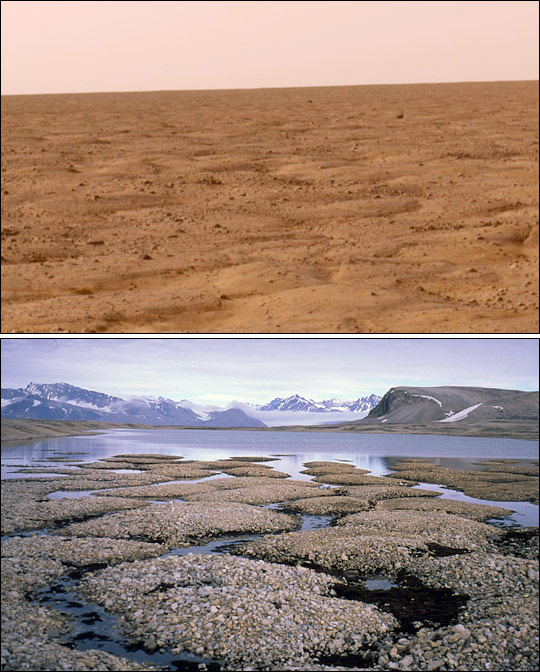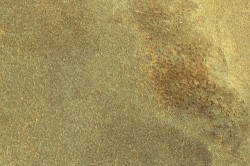Phoenix’s landing site may look flat and uninteresting. But actually, the site is perfect, and is exactly what the Phoenix science team was hoping for. You see, Phoenix is actually more interested in what is below the surface. From one of the first images sent back by Phoenix, a view of Mars’ surface at this site reveals a landscape familiar to polar scientists on Earth: a pattern of interlocking polygon shapes that form in permafrost that freezes and thaws seasonally. These polygon patterns were seen in orbital pictures taken by the Mars Reconnaissance Orbiter, as well as other spacecraft, and these polygon shapes are part of the evidence that Mars’ polar regions harbor large quantities of frozen water.
This pair of images above shows the similarities between the surface of Mars where Phoenix landed (top) and permafrost on northeastern Spitsbergen, Svalbard (bottom) an archipelago in the Arctic Ocean north of mainland Europe, about midway between Norway and the North Pole. The polygon patterns in the permafrost form when the upper parts of the ground thaw and refreeze from season to season. The ground contracts in the winter cold, creating small spaces that fill with melted water in the summer. When winter returns and the water freezes, it acts like a wedge, enlarging the cracks.
The Phoenix landing site with polygon shapes visible from orbit via MRO.
The only difference in these photos is the Earth image shows water on the surface, and on Mars, water couldn’t pool on the surface because the low atmospheric pressure would cause any water that might bubble to the surface to sublimate. But the thaw/freeze process could presumably occur beneath Mars’ surface with far less water.
And why is this so interesting? On Earth, permafrost, glaciers, and other frozen environments can preserve organic molecules, bacteria, and fungi for hundreds of thousands, even millions, of years. The Phoenix spacecraft has scientific instruments that will dig into the frozen ground of the Martian Arctic, vaporize the soil sample, and analyze the chemistry of the vapors. Scientists hope to learn whether ice just below the surface ever thaws and whether some chemical ingredients of life are preserved in the icy soil.
That’s why Phoenix’s landing site is perfect.
Original News Source: NASA Earth Observatory



Wow, the compare/contrast of the two really makes me glad we live on Earth…
I love this site, theres so much stuff every time I come back
For Vanesa… Another step for our species.. E.
ingenious…
This is just like with Opportunity landing in
Eagle Crater – sure, it looked flat and dull at first, but it turned out to be more scientifically signifigant than the landing sites of all previous successful Mars landers.
This should also be used as an example of telling babes how one may not look exciting on the outside, but inside we’ve got everything they want. :^)
Видела что-то подобное в англоÑзычном интернете, в Рунете про такое как-то не оÑобо чаÑто поÑÑ‚Ñ‹ увидишь.
Mars is what you get with too little greenhouse gases.
Venus is what you get when with too many greenhouse gases.
Zifferman,
I will always be a sucker for a hottie. Many like me will show no interest in Mars until terraforming begins to show results…
…in approximately one-hundred thousand years from now.
or never.